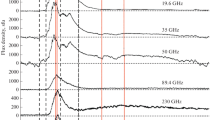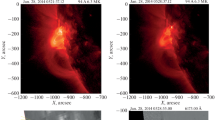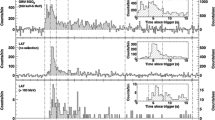Abstract
It is shown that the long time delays more than five seconds between the peaks of intense hard X-ray and microwave bursts are concerned with two independent phenomena. One is the energy dependent time delays in X-rays and the other is the frequency dependent time delays in microwaves.
The time delays of 5 s to 10 s between the peaks of solar hard X-ray burst (≲100 keV) obtained with Hinotori spacecraft and microwave burst at 17 GHz were observed exceptionally in three intense events with a spectral maximum at about 17 GHz. It is found that the peak of harder X-rays (≳300 keV) also delays in these events by about the same amount with respect to the softer X-rays (≲100 keV), so that the peak at 17 GHz nearly coincides (≲4s) with that of the harder X-rays. This is quite reasonable because the gyro-synchrotron emissions from the electrons below about 100 keV in the solar flares are generally negligible at high microwave frequencies (≳10 GHz). The optical thickness of the radio source decreases with frequency and is unity generally at about 10–20 GHz in intense bursts as inferred from the radio spectrum. Further delay of the peaks at the lower microwave frequencies is attributed to the temporal increase in the effective size of radio source which is optically thick at the lower frequencies.
Similar content being viewed by others
References
Bai, T. and Ramaty, R.: 1979, Astrophys. J. 227, 1072.
Bai, T., Hudson, H. S., Pelling, R. M., Lin, R. P., Schwarz, R. A., and Von Rosenvinge, T. T.: 1983, Astrophys. J. 267, 433.
Benz, A. O.: 1977, Astrophys. J. 211, 270.
Brown, J.: 1983, Solar Phys. 86, 227.
Costa, J. E. R. and Kaufmann, P.: 1983, Astron. Astrophys. 119, 131.
Crannell, C. J., Frost, K. J., Mäzler, C., Ohki, K., and Saba, J. L.: 1978, Astrophys. J. 223, 620.
Gaizauskas, V. and Tapping, K. F.: 1980, Astrophys. J. 241, 804.
Gotwoles, B. L.: 1973, Solar Phys. 33, 475.
Hoyng, P., Brown, J. C., and Van Beek, H. F.: 1976, Solar Phys. 48, 197.
Kakinuma, T., Yamashita, T., and Enome, S.: 1969, Proc. Res. Inst. Atm., Nagoya Univ., Japan 16, 127.
Kane, S. R.: 1974, in G. Newkirk Jr. (ed.), ‘Coronal Disturbances’, IAU Symp. 57, 105.
Kaufmann, P., Strauss, F. M., Opher, R., and Laporte, C.: 1980, Astron. Astrophys. 87, 58.
Kaufmann, P., Costa, J. E. R., and Strauss, F. M.: 1982, Solar Phys. 81, 159.
Kaufmann, P., Strauss, F. M., Costa, J. E. R., Denniss, B. R., Kiplinger, A., Frost, K. J., and Orwig, L. E.: 1983, Solar Phys. 84, 311.
Kawabata, K., Ogawa, H., Takakura, T., Tsuneta, S., Ohki, K, Yoshimori, M., Okudaira, K., Hirashima, Y., and Kondo, I.: 1982, Proceedings of Hinotori Symposium on Solar Flares, published by Institute of Space and Astronautical Science, Tokyo, p. 168.
Kundu, M. R., Schmahl, E. J., and Velusamy, T.: 1982, Astrophys. J. 253, 963.
Ohki, K., Nitta, N., Tsuneta, S., Takakura, T., Makishima, T., Murakami, T., Ogawara, Y., and Oda, M.: 1982, Proceedings of Hinotori Symposium on Solar Flares, published by Institute of Space and Astronautical Science, Tokyo, p. 69.
Ohki, K., Takakura, T., Tsuneta, S., and Nitta, N.: 1983, Solar Phys. 86, 301.
Pauliny-Toth, I. I. K. and Kellermann, K. I.: 1966, Astrophys. J. 146, 634.
Takakura, T.: 1972, Solar Phys. 26, 151.
Takakura, T.: 1975, in S. R. Kane (ed.), ‘Solar Gamma-, X-, and EUV Radiation’, IAU Symp. 68, 299.
Takakura, T. and Kai, K.: 1966, Publ. Astron. Soc. Japan 18, 57.
Takakura, T., Uchida, Y., and Kai, K.: 1968, Solar Phys. 4, 45 (corrigenda, 1969, Solar Phys. 6, 336).
Takakura, T., Ohki, K., Tsuneta, S., and Nitta, N.: 1983, Solar Phys. 86, 323.
Tsuneta, S.: 1983, Ph.D. Thesis, University of Tokyo.
Van der Laan, H.: 1966, Nature 211, 1131.
Vilmer, N., Kane, S. R., and Trottet, G.: 1982, Astron. Astrophys. 108, 306.
Wiehl, H. J., Schöchlin, W. A., and Magun, A.: 1980, Astron. Astrophys. 92, 260.
Yoshimori, M., Okudaira, K., and Hirashima, Y.: 1982, Proceedings of Hinotori Symposium on Solar Flares, published by Institute of Space and Astronautical Science, Tokyo, p. 230.
Author information
Authors and Affiliations
Additional information
On leave of absence from Physical Research Laboratory, Ahmedabad, India.
Rights and permissions
About this article
Cite this article
Takakura, T., Degaonkar, S.S., Ohki, K. et al. Long time delay between the peaks of intense solar hard X-ray and microwave bursts. Sol Phys 89, 379–390 (1983). https://doi.org/10.1007/BF00217257
Received:
Issue Date:
DOI: https://doi.org/10.1007/BF00217257




